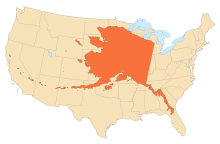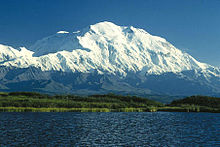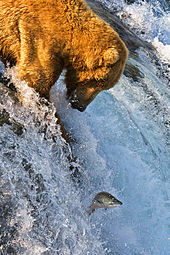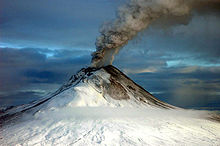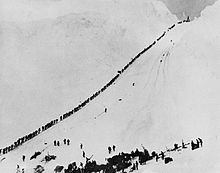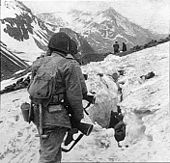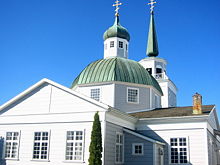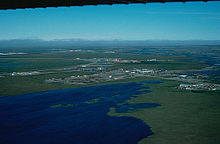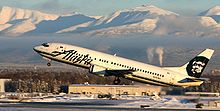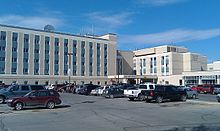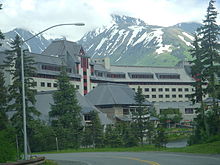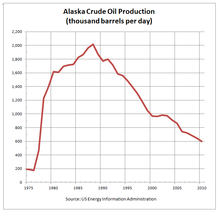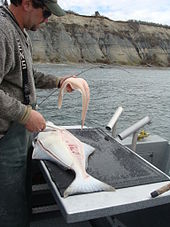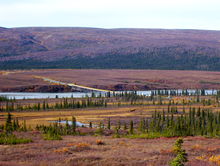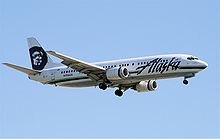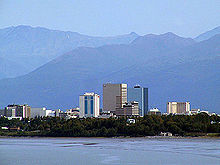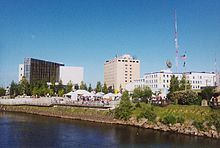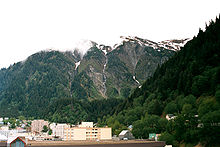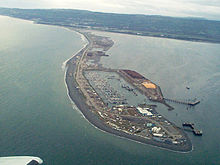- Alaska
-
"Alaskan" redirects here. For other uses, see Alaskan (disambiguation).
State of Alaska 

Flag Seal Nickname(s): The Last Frontier Motto(s): North to the Future Official language(s) None[1][2] Spoken language(s) English 89.7%,
Native North American 5.2%,
Spanish 2.9%Demonym Alaskan Capital Juneau Largest city Anchorage Area Ranked 1st in the U.S. - Total 663,268 sq mi
(1,717,854 km2)- Width 2,261 miles (3,639 km) - Length 1,420 miles (2,285 km) - % water 13.77 - Latitude 51°20'N to 71°50'N - Longitude 130°W to 172°E Population Ranked 47th in the U.S. - Total 710,231 (2010)[3]
626,932 (2000)- Density 1.07/sq mi (0.4/km2)
Ranked 50th in the U.S.- Median income US$64,333 (4th) Elevation - Highest point Mount McKinley (Denali)[4]
20,320 ft (6194 m)- Mean 1900 ft (580 m) - Lowest point Ocean[4]
sea levelBefore statehood Alaska Territory Admission to Union January 3, 1959 (49th) Governor Sean Parnell (R) Lieutenant Governor Mead Treadwell (R) Legislature Alaska Legislature - Upper house Senate - Lower house House of Representatives U.S. Senators Lisa Murkowski (R)
Mark Begich (D)U.S. House delegation Don Young (R) (at-large) (list) Time zones - east of 169° 30' Alaska: UTC-9/DST-8 - west of 169° 30' Aleutian: UTC-10/DST-9 Abbreviations AK US-AK Website alaska.gov Alaska
 i/əˈlæskə/ is the largest state in the United States by area. It is situated in the northwest extremity of the North American continent, with Canada to the east, the Arctic Ocean to the north, and the Pacific Ocean to the west and south, with Russia further west across the Bering Strait. Approximately half of Alaska's 710,231 residents (as per the 2010 United States Census) live within the Anchorage metropolitan area. Alaska is the least densely populated state of the U.S.[5]
i/əˈlæskə/ is the largest state in the United States by area. It is situated in the northwest extremity of the North American continent, with Canada to the east, the Arctic Ocean to the north, and the Pacific Ocean to the west and south, with Russia further west across the Bering Strait. Approximately half of Alaska's 710,231 residents (as per the 2010 United States Census) live within the Anchorage metropolitan area. Alaska is the least densely populated state of the U.S.[5]Alaska was purchased from the Russian Empire on March 30, 1867, for $7.2 million ($113 million in today's dollars) at approximately two cents per acre ($4.74/km²). The land went through several administrative changes before becoming an organized (or incorporated) territory on May 11, 1912, and the 49th state of the U.S. on January 3, 1959.
The name "Alaska" (Аляска) was already introduced in the Russian colonial period, when it was used only for the peninsula and is derived from the Aleut alaxsxaq, meaning "the mainland" or more literally, "the object towards which the action of the sea is directed".[6] It is also known as Alyeska, the "great land", an Aleut word derived from the same root.
Contents
Geography
Alaska has a longer coastline than all the other U.S. states combined.[7] It is the only non-contiguous U.S. state on continental North America; about 500 miles (800 km) of British Columbia (Canada) separate Alaska from Washington state. Alaska is thus an exclave of the United States. It is technically part of the continental U.S., but is often not included in colloquial use; Alaska is not part of the contiguous U.S., often called "the Lower 48".[8] The capital city, Juneau, is situated on the mainland of the North American continent, but is not connected by road to the rest of the North American highway system.
The state is bordered by the Yukon Territory and British Columbia in Canada, to the east, the Gulf of Alaska and the Pacific Ocean to the south, the Bering Sea, Bering Strait, and Chukchi Sea to the west and the Arctic Ocean to the north. Alaska's territorial waters touch Russia's territorial waters in the Bering Strait, as the Russian Big Diomede Island and Alaskan Little Diomede Island are only 3 miles (4.8 km) apart. With the extension of the Aleutian Islands into the eastern hemisphere, it is technically both the westernmost and easternmost state in the United States, as well as also being the northernmost.
Alaska is the largest state in the United States in land area at 586,412 square miles (1,518,800 km2), over twice the size of Texas, the next largest state. Alaska is larger than all but 18 sovereign countries. Counting territorial waters, Alaska is larger than the combined area of the next three largest states: Texas, California, and Montana. It is also larger than the combined area of the 22 smallest U.S. states.
Regions
There are no officially defined borders demarcating the various regions of Alaska, but there are six generally accepted regions:
South Central
Main article: South Central AlaskaThe most populous region of Alaska, containing Anchorage, the Matanuska-Susitna Valley and the Kenai Peninsula. Rural, mostly unpopulated areas south of the Alaska Range and west of the Wrangell Mountains also fall within the definition of Southcentral, as well as the Prince William Sound area and the communities of Cordova and Valdez.
Southeast
Main article: Southeast AlaskaAlso known as the Panhandle, this is the region of Alaska closest to the rest of the United States, and hence was where most initial non-Native settlement occurred following the Alaska Purchase. It contains the state capital, Juneau, the former capital, Sitka, and the large town of Ketchikan. The road systems leading from these cities are strictly local; no roads connect these communities to each other or any other communities apart from their own suburbs. The region is dominated by the Alexander Archipelago as well as the Tongass National Forest, the largest national forest in the United States.
Interior
The largest region of Alaska, much of it uninhabited wilderness. Fairbanks is the only community of any significant size. Small towns and Native villages are scattered throughout, mostly along the highway and river systems. Denali National Park and Preserve is located here, home to Mount McKinley (also widely known by its local name of Denali), the highest point in North America.
Southwest
A sparsely inhabited region stretching some 500 miles (800 km) inland from the Bering Sea. Most of the population lives along the coast. Kodiak Island is also located in Southwest. The massive Yukon–Kuskokwim Delta, one of the largest river deltas in the world, is here. Portions of the Alaska Peninsula are considered part of Southwest, with the remaining portions included with the Aleutian Islands (see below).
North Slope
The North Slope is mostly tundra peppered with small villages. The area is known for its massive reserves of crude oil, and contains both the National Petroleum Reserve–Alaska and the Prudhoe Bay Oil Field.[9] Barrow, the northernmost city in the United States, is located here. The Northwest Arctic area, anchored by Kotzebue and also containing the Kobuk River valley, is often regarded as being part of this region. However, the respective Inupiat of the North Slope and of the Northwest Arctic seldom think of themselves as one.
Aleutian Islands
More than 300 small, volcanic islands make up this chain, which stretches over 1,200 miles (1,900 km) into the Pacific Ocean. The International Date Line was drawn west of 180° to keep the whole state, and thus the entire North American continent, within the same legal day. However, because some of these islands fall in the Eastern Hemisphere, this makes Alaska the northernmost, easternmost and westernmost state in the union, with the southernmost state being Hawaii. Two of the islands, Attu and Kiska, were occupied by Japanese forces during World War II.
Natural features
With its myriad islands, Alaska has nearly 34,000 miles (54,720 km) of tidal shoreline. The Aleutian Islands chain extends west from the southern tip of the Alaska Peninsula. Many active volcanoes are found in the Aleutians and in coastal regions. Unimak Island, for example, is home to Mount Shishaldin, which is an occasionally smoldering volcano that rises to 10,000 feet (3,048 m) above the North Pacific. It is the most perfect volcanic cone on Earth, even more symmetrical than Japan's Mount Fuji. The chain of volcanoes extends to Mount Spurr, west of Anchorage on the mainland. Geologists have identified Alaska as part of Wrangellia, a large region consisting of multiple states and Canadian provinces in the Pacific Northwest which is actively undergoing continent building.
One of the world's largest tides occurs in Turnagain Arm, just south of Anchorage – tidal differences can be more than 35 feet (10.7 m). (Many sources say Turnagain has the second-greatest tides in North America, but several areas in Canada have larger tides.)[10]
Main article: List of lakes in AlaskaAlaska has more than three million lakes.[11][12] Marshlands and wetland permafrost cover 188,320 square miles (487,747 km2) (mostly in northern, western and southwest flatlands). Glacier ice covers some 16,000 square miles (41,440 km2) of land and 1,200 square miles (3,110 km2) of tidal zone. The Bering Glacier complex near the southeastern border with Yukon covers 2,250 square miles (5,827 km2) alone. With over 100,000, Alaska has half of the world's glaciers.
Land ownership
According to an October 1998 report by the United States Bureau of Land Management, approximately 65% of Alaska is owned and managed by the U.S. federal government as public lands, including a multitude of national forests, national parks, and national wildlife refuges. Of these, the Bureau of Land Management manages 87 million acres (35 million hectares), or 23.8% of the state. The Arctic National Wildlife Refuge is managed by the United States Fish and Wildlife Service. It is the world's largest wildlife refuge, comprising 16 million acres (6.5 million hectares).
Of the remaining land area, the state of Alaska owns 101 million acres (41 million hectares); its entitlement under the Alaska Statehood Act. A portion of that acreage is occasionally ceded to organized boroughs, under the statutory provisions pertaining to newly-formed boroughs. Smaller portions are set aside for rural subdivisions and other homesteading-related opportunities, though these are infrequently popular due to the often remote and roadless locations. The University of Alaska, as a land grant university, also owns substantial acreage which it manages independently.
Another 44 million acres (18 million hectares) are owned by 12 regional, and scores of local, Native corporations created under the Alaska Native Claims Settlement Act. Regional Native corporation Doyon, Limited often promotes itself as the largest private landowner in Alaska in advertisements and other communications. Provisions of ANCSA allowing the corporations' land holdings to be sold on the open market starting in 1991 were repealed before they could take effect. Effectively, the corporations hold title (including subsurface title in many cases, a privilege denied to individual Alaskans) but cannot sell the land. Individual Native allotments can be and are sold on the open market, however.
Various private interests own the remaining land, totaling about one percent of the state. Alaska is, by a large margin, the state with the smallest percentage of private land ownership when Native corporation holdings are excluded.
Climate
The climate in Juneau and the southeast panhandle is a mid-latitude oceanic climate (Köppen climate classification Cfb) in the southern sections and a subarctic oceanic climate (Köppen Cfc) in the northern parts. On an annual basis, the panhandle is both the wettest and warmest part of Alaska with milder temperatures in the winter and high precipitation throughout the year. Juneau averages over 50 inches (1,270 mm) of precipitation a year, while other areas receive over 275 inches (6,990 mm).[14] This is also the only region in Alaska in which the average daytime high temperature is above freezing during the winter months.
The climate of Anchorage and south central Alaska is mild by Alaskan standards due to the region's proximity to the seacoast. While the area gets less rain than southeast Alaska, it gets more snow, and days tend to be clearer. On average, Anchorage receives 16 inches (406 mm) of precipitation a year, with around 75 inches (191 cm) of snow, although there are areas in the south central which receive far more snow. It is a subarctic climate (Köppen Dfc) due to its brief, cool summers.
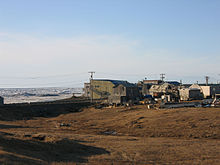 Barrow, known colloquially for many years by the nickname "Top of the World," is the northernmost city in the United States.
Barrow, known colloquially for many years by the nickname "Top of the World," is the northernmost city in the United States.
The climate of Western Alaska is determined in large part by the Bering Sea and the Gulf of Alaska. It is a subarctic oceanic climate in the southwest and a continental subarctic climate farther north. The temperature is somewhat moderate considering how far north the area is. This region has a tremendous amount of variety in precipitation. An area stretching from the northern side of the Seward Peninsula to the Kobuk River valley is technically a desert, with portions receiving less than 10 inches (254 mm) of precipitation annually. On the other extreme, some locations between Dillingham and Bethel average around 100 inches (2,540 mm) of precipitation.[14]
The climate of the interior of Alaska is subarctic. Some of the highest and lowest temperatures in Alaska occur around the area near Fairbanks. The summers may have temperatures reaching into the 90s°F (the low to mid 30s °C), while in the winter, the temperature can fall below −60 °F (−51.1 °C). Precipitation is sparse in the Interior, often less than 10 inches (254 mm) a year, but what precipitation falls in the winter tends to stay the entire winter.
The highest and lowest recorded temperatures in Alaska are both in the Interior. The highest is 100 °F (37.8 °C) in Fort Yukon (which is just 8 miles or 13 kilometers inside the arctic circle) on June 27, 1915,[15][16] making Alaska tied with Hawaii as the state with the lowest high temperature in the United States.[17][18] The lowest official Alaska temperature is −80 °F (−62.2 °C) in Prospect Creek on January 23, 1971,[15][16] one degree above the lowest temperature recorded in continental North America (in Snag, Yukon, Canada).[19]
The climate in the extreme north of Alaska is Arctic (Köppen ET) with long, very cold winters and short, cool summers. Even in July, the average low temperature in Barrow is 34 °F (1.1 °C).[20] Precipitation is light in this part of Alaska, with many places averaging less than 10 inches (254 mm) per year, mostly as snow which stays on the ground almost the entire year.
History
Alaska natives
Numerous indigenous peoples occupied Alaska for thousands of years before the arrival of European peoples to the area. The Tlingit people developed a matriarchal society in what is today Southeast Alaska, along with parts of British Columbia and the Yukon. Also in Southeast were the Haida, now well known for their unique arts, and the Tsimshian people, whose population were decimated by a smallpox epidemic in the 1860s. The Aleutian Islands are still home to the Aleut people's seafaring society, although they were among the first native Alaskans to be exploited by Russians. Western and Southwestern Alaska are home to the Yup'ik, while their cousins the Alutiiq lived in what is now Southcentral Alaska. The Gwich’in people of the northern Interior region are primarily known today for their dependence on the caribou within the much-contested Arctic National Wildlife Refuge. The North Slope and Little Diomede Island are occupied by the widespread Inuit people.
Colonization
Some researchers believe that the first Russian settlement in Alaska was established in 17th century.[21] According to this hypothesis, in 1648 several koches of Semyon Dezhnyov's expedition were thrown to Alaska by storm and founded this settlement. This hypothesis is based on the message of Chukchi geographer Nikolai Daurkin who had visited Alaska in 1764–1765 and reported about village on the Kheuveren river, populated by "bearded men" who "pray to the icons". Some modern researchers associate Kheuveren with Koyuk River.[22]
It is usually assumed that the first European boat to reach Alaska was «St. Gabriel» under the authority of the surveyor M. S. Gvozdev and assistant navigator I. Fyodorov on August 21, 1732 during expedition of Siberian cossak A. F. Shestakov adb Belorussian explorer D. I. Pavlutsky (1729—1735)[23]
Another European contact with Alaska occurred in 1741, when Vitus Bering led an expedition for the Russian Navy aboard the St. Peter. After his crew returned to Russia with sea otter pelts judged to be the finest fur in the world, small associations of fur traders began to sail from the shores of Siberia towards the Aleutian islands. The first permanent European settlement was founded in 1784. Between 1774 and 1800 Spain sent several expeditions to Alaska in order to assert its claim over the Pacific Northwest. In 1789 a Spanish settlement and fort were built in Nootka Sound. These expeditions gave names to places such as Valdez, Bucareli Sound, and Cordova. Later, the Russian-American Company carried out an expanded colonization program during the early-to-mid-19th century.
Sitka, renamed New Archangel from 1804 to 1867, on Baranof Island in the Alexander Archipelago in what is now Southeast Alaska, became the capital of Russian America and remained the capital after the colony was transferred to the United States. The Russians never fully colonized Alaska, and the colony was never very profitable.
William H. Seward, the United States Secretary of State, negotiated the Alaska Purchase (also known as Seward's Folly) with the Russians in 1867 for $7.2 million. Alaska was loosely governed by the military initially, and was administered as a district starting in 1884, with a governor appointed by the president of the United States, as well as a district court headquartered in Sitka.
For most of Alaska's first decade under the American flag, Sitka was the only community inhabited by American settlers. They organized a "provisional city government," which was Alaska's first city government, but not in a legal sense. Legislation allowing Alaskan communities to legally incorporate as cities did not come about until 1900, and home rule for cities was extremely limited or unavailable until statehood took effect.
U.S. Territory
Starting in the 1890s and stretching in some places to the early 1910s, gold rushes in Alaska and the nearby Yukon Territory brought thousands of miners and settlers to Alaska. Alaska was officially incorporated as an organized territory in 1912. Alaska's capital, which had been in Sitka until the 1900 legislation mandated its transfer to Juneau (the actual move took place in 1906, after initial questions arose), begun to take shape with the construction of the Alaska Governor's Mansion that same year.
During World War II, the Aleutian Islands Campaign focused on the three outer Aleutian Islands – Attu, Agattu and Kiska[24] – that were invaded by Japanese troops and occupied between June 1942 and August 1943. Unalaska/Dutch Harbor became a significant base for the U.S. Army Air Corps and Navy submariners.
The U.S. Lend-Lease program involved the flying of American warplanes through Canada to Fairbanks and thence Nome; Soviet pilots took possession of these aircraft, ferrying them to fight the German invasion of the Soviet Union. The construction of military bases contributed to the population growth of some Alaskan cities.
Statehood
Statehood for Alaska was an important cause of James Wickersham early in his tenure as a congressional delegate. Decades later, the statehood movement gained its first real momentum following a territorial referendum in 1946. The Alaska Statehood Committee and Alaska's Constitutional Convention would soon follow. Statehood supporters also found themselves fighting major battles against political foes, mostly in the U.S. Congress but also within Alaska. Statehood was approved by Congress on July 7, 1958. Alaska was officially proclaimed a state on January 3, 1959.
On April 27, 1964, the massive "Good Friday Earthquake" killed 133 people and destroyed several villages and portions of large coastal communities, mainly by the resultant tsunamis and landslides. It was the third most powerful earthquake in the recorded history of the world, with a moment magnitude of 9.2. It was over one thousand times more powerful than the 1989 San Francisco earthquake. The time of day (5:36 pm), time of year and location of the epicenter were all cited as factors in potentially sparing thousands of lives, particularly in Anchorage.
The 1968 discovery of oil at Prudhoe Bay and the 1977 completion of the Trans-Alaska Pipeline led to an oil boom. Royalty revenues from oil have funded large state budgets from 1980 onward. That same year, not coincidentally, Alaska repealed its state income tax. In 1989, the Exxon Valdez hit a reef in the Prince William Sound, spilling over 11,000,000 US gallons (42,000 m3) of crude oil over 1,100 miles (1,600 km) of coastline. Today, the battle between philosophies of development and conservation is seen in the contentious debate over oil drilling in the Arctic National Wildlife Refuge.
Demographics
Historical populations Census Pop. %± 1880 33,426 — 1890 32,052 −4.1% 1900 63,592 98.4% 1910 64,356 1.2% 1920 55,036 −14.5% 1930 59,278 7.7% 1940 72,524 22.3% 1950 128,643 77.4% 1960 226,167 75.8% 1970 300,382 32.8% 1980 401,851 33.8% 1990 550,043 36.9% 2000 626,932 14.0% 2010 710,231 13.3% 1930 and 1940 censuses taken in preceding autumn
Sources: 1910–2010[25]The United States Census Bureau, as of July 1, 2008, estimated Alaska's population at 686,293,[3] which represents an increase of 59,361, or 9.5%, since the last census in 2000.[26] This includes a natural increase since the last census of 60,994 people (that is 86,062 births minus 25,068 deaths) and a decrease due to net migration of 5,469 people out of the state.[26] Immigration from outside the U.S. resulted in a net increase of 4,418 people, and migration within the country produced a net loss of 9,887 people.[26]
In 2000 Alaska ranked the 48th state by population, ahead of Vermont and Wyoming (and Washington D.C.).[27] Alaska is the least densely populated state, and one of the most sparsely populated areas in the world, at 1.0 person per square mile (0.42/km²), with the next state, Wyoming, at 5.1 per square mile (1.97/km²). Alaska is the largest U.S. state by area, and the sixth wealthiest (per capita income). As of January 2010, the state's unemployment rate is 8.5%.[28]
Race and ancestry
According to the 2010 U.S. Census, Alaska had a population of 710,231. In terms of race and ethnicity, the state was 66.7% White (64.7% Non-Hispanic White Alone), 14.8% American Indian and Alaska Native, 5.4% Asian, 3.3% Black or African American, 1.0% Native Hawaiian and Other Pacific Islander, 1.6% from Some Other Race, and 7.3% from Two or More Races. Hispanics or Latinos of any race made up 5.5% of the population.[29]
Languages
According to the 2005–2007 American Community Survey, 84.7% of people over the age of five speak only English at home. About 3.5% speak Spanish at home. About 2.2% speak another Indo-European language at home and about 4.3% speak an Asian language at home. And about 5.3% speak other languages at home.[30]
A total of 5.2% of Alaskans speak one of the state's 22 indigenous languages, known locally as "native languages". These languages belong to two major language families: Eskimo–Aleut and Na-Dene. As the homeland of these two major language families of North America, Alaska has been described as the crossroads of the continent, providing evidence for the recent settlement of North America by way of the Bering land bridge.
Religion
Alaska has been identified, along with Pacific Northwest states Washington and Oregon, as being the least religious in the U.S.[31][32] According to statistics collected by the Association of Religion Data Archives, about 39% of Alaska residents were members of religious congregations. Evangelical Protestants had 78,070 members, Roman Catholics had 54,359, and mainline Protestants had 37,156.[33] After Catholicism, the largest single denominations are The Church of Jesus Christ of Latter-day Saints with 30,169,[34] and Southern Baptists with 22,959. The large Eastern Orthodox (with 49 parishes and up to 50,000 followers)[35] population is a result of early Russian colonization and missionary work among Alaska Natives.[36]
In 1795, the First Russian Orthodox Church was established in Kodiak. Intermarriage with Alaskan Natives helped the Russian immigrants integrate into society. As a result, an increasing number of Russian Orthodox churches[37] gradually became established within Alaska. Alaska also has the largest Quaker population (by percentage) of any state.[38] In 2009 there were 6,000 Jews in Alaska (for whom observance of the mitzvah may pose special problems).[39] Estimates for the number of Alaskan Muslims range from 2,000[40][41] to 5,000.[42] In 2010, the local Muslim community broke ground on the first mosque in the state.[43] Alaskan Hindus often share venues and celebrations with members of other religious communities including Sikhs and Jains.[44][45][46]
Economy
Main article: Economy of AlaskaThe 2007 gross state product was $44.9 billion, 45th in the nation. Its per capita personal income for 2007 was $40,042, ranking 15th in the nation. The oil and gas industry dominates the Alaskan economy, with more than 80% of the state's revenues derived from petroleum extraction. Alaska's main export product (excluding oil and natural gas) is seafood, primarily salmon, cod, Pollock and crab.
Agriculture represents only a fraction of the Alaskan economy. Agricultural production is primarily for consumption within the state and includes nursery stock, dairy products, vegetables, and livestock. Manufacturing is limited, with most foodstuffs and general goods imported from elsewhere.
Employment is primarily in government and industries such as natural resource extraction, shipping, and transportation. Military bases are a significant component of the economy in both Fairbanks and Anchorage. Federal subsidies are also an important part of the economy, allowing the state to keep taxes low. Its industrial outputs are crude petroleum, natural gas, coal, gold, precious metals, zinc and other mining, seafood processing, timber and wood products. There is also a growing service and tourism sector. Tourists have contributed to the economy by supporting local lodging.
Largest employers
According to the Alaska Department of Labor and Workforce Development, the following were the state's largest private sector employers in 2010:[47]
Rank Employer name Average monthly
employment in 20101 Providence Health & Services 4,000+ 2 Walmart/Sam's Club 3,000-3,249 3 Carrs Safeway Alaska Division 2,750-2,999 4 Fred Meyer 2,500-2,749 5 ASRC Energy Services 2,500-2,749 6 Trident Seafoods 2,250-2,499 7 BP Exploration Alaska 2,000-2,249 8 CH2M HILL 1,750-1,999 9 NANA Management Services 1,750-1,999 10 Alaska Native Tribal Health Consortium 1,500-1,749 11 Alaska Airlines 1,500-1,749 12 GCI Communications 1,250-1,499 13 Banner Health
(includes Fairbanks Memorial Hospital)1,250-1,499 14 Southcentral Foundation 1,250-1,499 15 Yukon-Kuskokwim Health Corporation 1,000-1,249 16 FedEx 1,000-1,249 17 ConocoPhillips Alaska 1,000-1,249 18 Alaska USA Federal Credit Union 1,000-1,249 19 United Parcel Service 1,000-1,249 20 McDonald's Restaurants of Alaska 750-999 21 Wells Fargo 750-999 22 Doyon Universal Services 750-999 23 Home Depot 750-999 24 Alaska Regional Hospital 750-999 25 The Alaska Club 750-999 26 Icicle Seafoods 750-999 27 Southeast Alaska Regional Health Consortium 750-999 28 Hope Community Resources 750-999 29 UniSea 750-999 30 Alaska Commercial Company 750-999 31 Costco 750-999 32 Spenard Builders Supply 750-999 33 Lowe's 750-999 34 Alyeska Pipeline Service Company 750-999 35 Alaska Communication Systems 500-749 36 First National Bank Alaska 500-749 37 Central Peninsula Hospital 500-749 38 First Student 500-749 39 Westward Seafood 500-749 40 Mat-Su Regional Medical Center 500-749 41 Alaska Consumer Direct Personal Care 500-749 42 Tanana Chiefs Conference 500-749 43 PeterPan Seafoods 500-749 44 Udelhoven Oilfield System Services 500-749 45 Job Ready/ReadyCare 500-749 46 Schlumberger Technologies 500-749 47 Maniilaq Association 500-749 48 Alaska Hotel Properties/Princess Hotels 500-749 49 Alyeska Resort
(includes O'Malley's on the Green)500-749 50 Ocean Beauty Seafoods 250-499 Energy
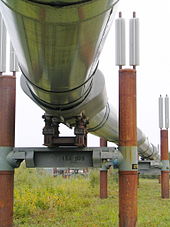 The Trans-Alaska Pipeline transports oil, Alaska's most financially important export, from the North Slope to Valdez. Pertinent are the heat pipes in the column mounts, which disperses heat upwards and prevents melting of permafrost.
The Trans-Alaska Pipeline transports oil, Alaska's most financially important export, from the North Slope to Valdez. Pertinent are the heat pipes in the column mounts, which disperses heat upwards and prevents melting of permafrost.
Alaska has vast energy resources. Major oil and gas reserves are found in the Alaska North Slope (ANS) and Cook Inlet basins. According to the Energy Information Administration, Alaska ranks second in the nation in crude oil production. Prudhoe Bay on Alaska's North Slope is the highest yielding oil field in the United States and on North America, typically producing about 400,000 barrels per day (64,000 m3/d).
The Trans-Alaska Pipeline can transport and pump up to 2.1 million barrels (330,000 m3) of crude oil per day, more than any other crude oil pipeline in the United States. Additionally, substantial coal deposits are found in Alaska's bituminous, sub-bituminous, and lignite coal basins. The United States Geological Survey estimates that there are 85.4 trillion cubic feet (2,420 km3) of undiscovered, technically recoverable gas from natural gas hydrates on the Alaskan North Slope.[48] Alaska also offers some of the highest hydroelectric power potential in the country from its numerous rivers. Large swaths of the Alaskan coastline offer wind and geothermal energy potential as well.[49]
Alaska's economy depends heavily on increasingly expensive diesel fuel for heating, transportation, electric power and light. Though wind and hydroelectric power are abundant and underdeveloped, proposals for state-wide energy systems (e.g. with special low-cost electric interties) were judged uneconomical (at the time of the report, 2001) due to low (<$0.50/Gal) fuel prices, long distances and low population.[50] The cost of a US gallon of gas in urban Alaska today is usually $0.30–$0.60 higher than the national average; prices in rural areas are generally significantly higher but vary widely depending on transportation costs, seasonal usage peaks, nearby petroleum development infrastructure and many other factors.
Alaska accounts for one-fifth (20 percent)[citation needed] of domestically produced United States oil production. Prudhoe Bay (North America's largest oil field) alone accounts for 8% of the U.S. domestic oil production.
Permanent Fund
The Alaska Permanent Fund is a constitutionally authorized appropriation of oil revenues, established by voters in 1976 to manage a surplus in state petroleum revenues from oil, largely in anticipation of same from the recently constructed Trans-Alaska Pipeline System. The fund was originally proposed by Governor Keith Miller on the eve of the 1969 Prudhoe Bay lease sale, out of fear that the legislature would spend the entire proceeds of the sale (which amounted to $900 million (US)) at once, and was later championed by Governor Jay Hammond and Kenai state representative Hugh Malone. It has served as an attractive political prospect ever since, diverting revenues which would normally be deposited into the general fund.
The Alaska Constitution was written so as to discourage dedicating state funds for a particular purpose. The Permanent Fund has become the rare exception to this, mostly due to the political climate of distrust existing during the time of its creation. From its initial principal of $734,000, the fund has grown to $40 billion as a result of oil royalties and capital investment programs.[51] Most if not all the principal is invested conservatively outside Alaska. This has led to frequent calls by Alaskan politicians for the Fund to make investments within Alaska, though such a stance has never really gained momentum.
Starting in 1982, dividends from the fund's annual growth have been paid out each year to eligible Alaskans, ranging from an initial $1,000.00 in 1982 (equal to three years' payout, as the distribution of payments was held up in a lawsuit over the distribution scheme) to $3,269.00 in 2008 (which included a one-time $1,200.00 "Resource Rebate"). Every year, the state legislature takes out 8 percent from the earnings, puts 3 percent back into the principal for inflation proofing, and the remaining 5 percent is distributed to all qualifying Alaskans. To qualify for the Permanent Fund Dividend, one must have lived in the state for a minimum of 12 months, maintain constant residency subject to allowable absences,[52] and not be subject to court judgments or criminal convictions which fall under various disqualifying classifications or may subject the payment amount to civil garnishment.
Cost of living
The cost of goods in Alaska has long been higher than in the contiguous 48 states. This has changed for the most part in Anchorage and to a lesser extent in Fairbanks, where the cost of living has dropped somewhat in the past five years. Federal government employees, particularly United States Postal Service (USPS) workers and active-duty military members, receive a Cost of Living Allowance usually set at 25% of base pay because, while the cost of living has gone down, it is still one of the highest in the country.
The introduction of big-box stores in Anchorage, Fairbanks, and Juneau also did much to lower prices. Wal-Mart opened their first Anchorage store in 1993, and debuted in Fairbanks in 2004. The company currently has locations covering most of the population centers of Alaska, including Juneau, Ketchikan and Kodiak. However, rural Alaska suffers from extremely high prices for food and consumer goods, compared to the rest of the country due to the relatively limited transportation infrastructure. Many rural residents come into these cities and purchase food and goods in bulk from warehouse clubs like Costco and Sam's Club. Some have embraced the free shipping offers[53] of some online retailers to purchase items much more cheaply than they could in their own communities, if they are available at all.
Agriculture
Due to the northern climate and steep terrain, relatively little farming occurs in Alaska. Most farms are in either the Matanuska Valley, about 40 miles (64 km) northeast of Anchorage, or on the Kenai Peninsula, about 60 miles (97 km) southwest of Anchorage. The short 100-day growing season limits the crops that can be grown, but the long sunny summer days make for productive growing seasons. The primary crops are potatoes, carrots, lettuce, and cabbage. The Delta Junction area, about 100 miles (160 km) southeast of Fairbanks, also has a sizable concentration of farms, which mostly lie north and east of Fort Greely. This area was largely set aside and developed under a state program spearheaded by Hammond during his second term as governor. Delta-area crops consist predominately of barley and hay.
Alaska, with no counties, also lacks county fairs. However, a small assortment of state and local fairs (with the Alaska State Fair in Palmer the largest), are held mostly in the late summer. The fairs are mostly located in communities with historic or current agricultural activity, and feature local farmers exhibiting produce in addition to more high-profile commercial activities such as carnival rides, concerts and food. "Alaska Grown" is used as an agricultural slogan.
Alaska has an abundance of seafood, with the primary fisheries in the Bering Sea and the North Pacific, and seafood is one of the few food items that is often cheaper within the state than outside it. Many Alaskans take advantage of salmon seasons to harvest portions of their household diet while fishing for subsistence, as well as sport. This includes fish taken by hook, net or wheel.[54]
Hunting for subsistence, primarily caribou, moose, and Dall sheep is still common in the state, particularly in remote Bush communities. An example of a traditional native food is Akutaq, the Eskimo ice cream, which can consist of reindeer fat, seal oil, dried fish meat and local berries.
Alaska's reindeer herding is concentrated on Seward Peninsula where wild caribou can be prevented from mingling and migrating with the domesticated reindeer.[55]
Most food in Alaska is transported into the state from "Outside", and shipping costs make food in the cities relatively expensive. In rural areas, subsistence hunting and gathering is an essential activity because imported food is prohibitively expensive. The cost of importing food to villages begins at 7¢ per pound (15¢/kg) and rises rapidly to 50¢ per pound ($1.10/kg) or more. The cost of delivering a 1 US gallon (3.8 L) of milk is about $3.50 in many villages where per capita income can be $20,000 or less. Fuel cost can exceed $8.00 per gallon.
Transportation
Roads
Alaska has few road connections compared to the rest of the U.S. The state's road system covers a relatively small area of the state, linking the central population centers and the Alaska Highway, the principal route out of the state through Canada. The state capital, Juneau, is not accessible by road, only a car ferry, which has spurred several debates over the decades about moving the capital to a city on the road system, or building a road connection from Haines. The western part of Alaska has no road system connecting the communities with the rest of Alaska.
One unique feature of the Alaska Highway system is the Anton Anderson Memorial Tunnel, an active Alaska Railroad tunnel recently upgraded to provide a paved roadway link with the isolated community of Whittier on Prince William Sound to the Seward Highway about 50 miles (80 km) southeast of Anchorage at Portage. At 2.5 miles (4.0 km) the tunnel was the longest road tunnel in North America until 2007.[56] The tunnel is the longest combination road and rail tunnel in North America.
Rail
Built around 1915, the Alaska Railroad (ARR) played a key role in the development of Alaska through the 20th century. It links north Pacific shipping through providing critical infrastructure with tracks that run from Seward to Interior Alaska by way of South Central Alaska, passing through Anchorage, Eklutna, Wasilla, Talkeetna, Denali, and Fairbanks, with spurs to Whittier, Palmer and North Pole. The cities, towns, villages, and region served by ARR tracks are known statewide as "The Railbelt". In recent years, the ever-improving paved highway system began to eclipse the railroad's importance in Alaska's economy.
The railroad, though famed for its summertime tour passenger service, played a vital role in Alaska's development, moving freight into Alaska while transporting natural resources southward (i.e., coal from the Usibelli coal mine near Healy to Seward and gravel from the Matanuska Valley to Anchorage).
The Alaska Railroad was one of the last railroads in North America to use cabooses in regular service and still uses them on some gravel trains. It continues to offer one of the last flag stop routes in the country. A stretch of about 60 miles (100 km) of track along an area north of Talkeetna remains inaccessible by road; the railroad provides the only transportation to rural homes and cabins in the area; until construction of the Parks Highway in the 1970s, the railroad provided the only land access to most of the region along its entire route.
In northern Southeast Alaska, the White Pass and Yukon Route also partly runs through the state from Skagway northwards into Canada (British Columbia and Yukon Territory), crossing the border at White Pass Summit. This line is now mainly used by tourists, often arriving by cruise liner at Skagway. It featured in the 1983 BBC television series Great Little Railways.
The Alaska Rail network is not connected to Outside. In 2000, the U.S. Congress authorized $6 million to study the feasibility of a rail link between Alaska, Canada, and the lower 48.[57][58][59]
Alaska Rail Marine provides car float service between Whittier and Seattle.
Marine transport
Many cities, towns and villages in the state do not have road or highway access; the only modes of access involve travel by air, river, or the sea.
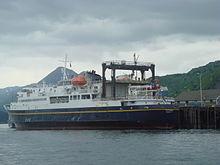 The M/V Tustumena (named after Tustumena Glacier) is one of the state's many ferries, providing service between the Kenai Peninsula and Kodiak Island.
The M/V Tustumena (named after Tustumena Glacier) is one of the state's many ferries, providing service between the Kenai Peninsula and Kodiak Island.
Alaska's well-developed state-owned ferry system (known as the Alaska Marine Highway) serves the cities of southeast, the Gulf Coast and the Alaska Peninsula. The ferries transport vehicles as well as passengers. The system also operates a ferry service from Bellingham, Washington and Prince Rupert, British Columbia in Canada through the Inside Passage to Skagway. The Inter-Island Ferry Authority also serves as an important marine link for many communities in the Prince of Wales Island region of Southeast and works in concert with the Alaska Marine Highway.
In recent years, cruise lines have created a summertime tourism market, mainly connecting the Pacific Northwest to Southeast Alaska and, to a lesser degree, towns along Alaska's gulf coast. The population of Ketchikan may rise by over 10,000 people on many days during the summer, as up to four large cruise ships at a time can dock, debarking thousands passengers.
Air transport
Cities not served by road, sea, or river can be reached only by air, foot, dogsled, or snowmachine accounting for Alaska's extremely well developed bush air services—an Alaskan novelty. Anchorage itself, and to a lesser extent Fairbanks, are served by many major airlines. Because of limited highway access, air travel remains the most efficient form of transportation in and out of the state. Anchorage recently completed extensive remodeling and construction at Ted Stevens Anchorage International Airport to help accommodate the upsurge in tourism (in 2000–2001, the latest year for which data is available, 2.4 million total arrivals to Alaska were counted, 1.7 million by air travel; 1.4 million were visitors).[60][61]
Regular flights to most villages and towns within the state that are commercially viable are challenging to provide, so they are heavily subsidized by the federal government through the Essential Air Service program. Alaska Airlines is the only major airline offering in-state travel with jet service (sometimes in combination cargo and passenger Boeing 737-400s) from Anchorage and Fairbanks to regional hubs like Bethel, Nome, Kotzebue, Dillingham, Kodiak, and other larger communities as well as to major Southeast and Alaska Peninsula communities.
The bulk of remaining commercial flight offerings come from small regional commuter airlines such as Era Aviation, PenAir, and Frontier Flying Service. The smallest towns and villages must rely on scheduled or chartered bush flying services using general aviation aircraft such as the Cessna Caravan, the most popular aircraft in use in the state. Much of this service can be attributed to the Alaska bypass mail program which subsidizes bulk mail delivery to Alaskan rural communities. The program requires 70% of that subsidy to go to carriers who offer passenger service to the communities.
Many communities have small air taxi services. These operations originated from the demand for customized transport to remote areas. Perhaps the most quintessentially Alaskan plane is the bush seaplane. The world's busiest seaplane base is Lake Hood, located next to Ted Stevens Anchorage International Airport, where flights bound for remote villages without an airstrip carry passengers, cargo, and many items from stores and warehouse clubs. Alaska has the highest number of pilots per capita of any U.S. state: out of the estimated 663,661 residents, 8,550 are pilots, or about one in 78.[62]
Other transport
Another Alaskan transportation method is the dogsled. In modern times (that is, any time after the mid-late 1920s), dog mushing is more of a sport than a true means of transportation. Various races are held around the state, but the best known is the Iditarod Trail Sled Dog Race, a 1150-mile (1850 km) trail from Anchorage to Nome (although the distance varies from year to year, the official distance is set at 1,049 miles (1,688 km)). The race commemorates the famous 1925 serum run to Nome in which mushers and dogs like Togo and Balto took much-needed medicine to the diphtheria-stricken community of Nome when all other means of transportation had failed. Mushers from all over the world come to Anchorage each March to compete for cash, prizes, and prestige. The "Serum Run" is another sled dog race that more accurately follows the route of the famous 1925 relay, leaving from the community of Nenana (southwest of Fairbanks) to Nome.[63]
In areas not served by road or rail, primary transportation in summer is by all-terrain vehicle and in winter by snowmobile or "snow machine," as it is commonly referred to in Alaska.
Law and government
State government
 The center of state government in Juneau. The large buildings in the background are, from left to right: the Court Plaza Building (colloquially known as the "Spam Can"), the State Office Building (behind), the Alaska Office Building, the John H. Dimond State Courthouse, and the Alaska State Capitol. Many of the smaller buildings in the foreground are also occupied by state government agencies.
The center of state government in Juneau. The large buildings in the background are, from left to right: the Court Plaza Building (colloquially known as the "Spam Can"), the State Office Building (behind), the Alaska Office Building, the John H. Dimond State Courthouse, and the Alaska State Capitol. Many of the smaller buildings in the foreground are also occupied by state government agencies.
Like all other U.S. states, Alaska is governed as a republic, with three branches of government: an executive branch consisting of the Governor of Alaska and the other independently elected constitutional officers; a legislative branch consisting of the Alaska House of Representatives and Alaska Senate; and a judicial branch consisting of the Alaska Supreme Court and lower courts.
The state of Alaska employs approximately 15,000 employees statewide.[64]
The Alaska Legislature consists of a 40-member House of Representatives and a 20-member Senate. Senators serve four year terms and House members two. The Governor of Alaska serves four-year terms. The lieutenant governor runs separately from the governor in the primaries, but during the general election, the nominee for governor and nominee for lieutenant governor run together on the same ticket.
Alaska's court system has four levels: the Alaska Supreme Court, the court of appeals, the superior courts and the district courts.[65] The superior and district courts are trial courts. Superior courts are courts of general jurisdiction, while district courts only hear certain types of cases, including misdemeanor criminal cases and civil cases valued up to $100,000.[65] The Supreme Court and the Court Of Appeals are appellate courts. The Court Of Appeals is required to hear appeals from certain lower-court decisions, including those regarding criminal prosecutions, juvenile delinquency, and habeas corpus.[65] The Supreme Court hears civil appeals and may in its discretion hear criminal appeals.[65]
State politics
Although Alaska entered the union as a Democratic state, since the early 1970s Alaska has been characterized as a Republican-leaning state.[66] Local political communities have often worked on issues related to land use development, fishing, tourism, and individual rights. Alaska Natives, while organized in and around their communities, have been active within the Native corporations. These have been given ownership over large tracts of land, which require stewardship.
Alaska is the only state in which possession of one ounce or less of marijuana in one's home is completely legal under state law, though the federal law remains in force.[67]
The state has an independence movement favoring a vote on secession from the United States, with the Alaskan Independence Party labeled as one of "the most significant state-level third parties operating in the 20th century".[68]
Six Republicans and four Democrats have served as governor of Alaska. In addition, Republican Governor Wally Hickel was elected to the office for a second term in 1990 after leaving the Republican party and briefly joining the Alaskan Independence Party ticket just long enough to be reelected. He subsequently officially rejoined the Republican party in 1994.
Taxes
To finance state government operations, Alaska depends primarily on petroleum revenues and federal subsidies. This allows it to have the lowest individual tax burden in the United States,[69] and be one of only five states with no state sales tax, one of seven states that do not levy an individual income tax, and one of two states that has neither. The Department of Revenue Tax Division[70] reports regularly on the state's revenue sources. The Department also issues an annual summary of its operations, including new state laws that directly affect the tax division.
While Alaska has no state sales tax, 89 municipalities collect a local sales tax, from 1–7.5%, typically 3–5%. Other local taxes levied include raw fish taxes, hotel, motel, and bed-and-breakfast 'bed' taxes, severance taxes, liquor and tobacco taxes, gaming (pull tabs) taxes, tire taxes and fuel transfer taxes. A part of the revenue collected from certain state taxes and license fees (such as petroleum, aviation motor fuel, telephone cooperative) is shared with municipalities in Alaska.
Fairbanks has one of the highest property taxes in the state as no sales or income taxes are assessed in the Fairbanks North Star Borough (FNSB). A sales tax for the FNSB has been voted on many times, but has yet to be approved, leading law makers to increase taxes dramatically on other goods such as liquor and tobacco.
In 2008 the Tax Foundation ranked Alaska as having the 4th most "business friendly" tax policy. More "friendly" states were Wyoming, Nevada, and South Dakota.[71]
Federal politics
Presidential elections results Year Republican Democratic 2008 59.49% 192,631 37.83% 122,485 2004 61.07% 190,889 35.52% 111,025 2000 58.62% 167,398 27.67% 79,004 1996 50.80% 122,746 33.27% 80,380 1992 39.46% 102,000 30.29% 78,294 1988 59.59% 119,251 36.27% 72,584 1984 66.65% 138,377 29.87% 62,007 1980 54.35% 86,112 26.41% 41,842 1976 57.90% 71,555 35.65% 44,058 1972 58.13% 55,349 34.62% 32,967 1968 45.28% 37,600 42.65% 35,411 1964 34.09% 22,930 65.91% 44,329 1960 50.94% 30,953 49.06% 29,809 In presidential elections, the state's electoral college votes have been won by the Republican nominee in every election since statehood, except for 1964. No state has voted for a Democratic presidential candidate fewer times. Alaska supported Democratic nominee Lyndon B. Johnson in the landslide year of 1964, and the 1960 and 1968 elections were close. Since 1972, however, Republicans have carried the state by large margins. In 2008, Republican John McCain defeated Democrat Barack Obama in Alaska, 59.49% to 37.83%. McCain's running mate was Sarah Palin, the state's governor and the first Alaskan on a major party ticket.
The Alaska Bush, central Juneau, midtown and downtown Anchorage, and the area surrounding the University of Alaska Fairbanks campus have been strongholds of the Democratic Party. Matanuska-Susitna Borough and South Anchorage typically have the strongest Republican showing. As of 2004, well over half of all registered voters have chosen "Non-Partisan" or "Undeclared" as their affiliation,[72] despite recent attempts to close primaries.
Because of its population relative to other U.S. states, Alaska has only one member in the U.S. House of Representatives. This seat is currently being held by Republican Don Young, who was re-elected to his 19th consecutive term in 2008. Alaska's At-large congressional district is currently the world's second-largest legislative constituency by area, behind only the Canadian territory of Nunavut.
In 2008, Governor Sarah Palin became the first Republican woman to run on a national ticket when she became John McCain's Vice Presidential running mate. She continued to be a prominent national figure even after resigning from the governor's job in July 2009.
Alaska's United States Senators belong to Class 2 and Class 3. In 2008, Democrat Mark Begich, mayor of Anchorage, defeated long-time Republican senator Ted Stevens. Stevens had been convicted on seven felony counts of failing to report gifts on Senate financial discloser forms one week before the election. The conviction was set aside in April 2009 after evidence of prosecutorial misconduct emerged.
Republican Frank Murkowski held the state's other senatorial position. After being elected governor in 2002, he resigned from the Senate and appointed his daughter, State Representative Lisa Murkowski as his successor. She won a full six-year term in 2004 and 2010.
Cities, towns and boroughs
Alaska is not divided into counties, as most of the other U.S. states, but it is divided into boroughs. Many of the more densely populated parts of the state are part of Alaska's 16 boroughs, which function somewhat similarly to counties in other states. However, unlike county-equivalents in the other 49 states, the boroughs do not cover the entire land area of the state. The area not part of any borough is referred to as the Unorganized Borough.
The Unorganized Borough has no government of its own, but the U.S. Census Bureau in cooperation with the state divided the Unorganized Borough into 11 census areas solely for the purposes of statistical analysis and presentation. A recording district is a mechanism for administration of the public record in Alaska. The state is divided into 34 recording districts which are centrally administered under a State Recorder. All recording districts use the same acceptance criteria, fee schedule, etc., for accepting documents into the public record.
Whereas many U.S. states use a three-tiered system of decentralization—state/county/township—most of Alaska uses only two tiers—state/borough. Owing to the low population density, most of the land is located in the Unorganized Borough which, as the name implies, has no intermediate borough government of its own, but is administered directly by the state government. Currently (2000 census) 57.71% of Alaska's area has this status, with 13.05% of the population.
For statistical purposes the United States Census Bureau divides this territory into census areas. Anchorage merged the city government with the Greater Anchorage Area Borough in 1975 to form the Municipality of Anchorage, containing the city proper and the communities of Eagle River, Chugiak, Peters Creek, Girdwood, Bird, and Indian. Fairbanks has a separate borough (the Fairbanks North Star Borough) and municipality (the City of Fairbanks).
The state's most populous city is Anchorage, home to 278,700 people in 2006, 225,744 of whom live in the urbanized area. The richest location in Alaska by per capita income is Halibut Cove ($89,895). Yakutat City, Sitka, Juneau, and Anchorage are the four largest cities in the U.S. by area.
- Cities of 100,000 or more people
- Cities and census-designated places of 10,000–100,000 people
- Fairbanks
- Juneau (State Capital)
- Knik-Fairview
- College
- Cities and census-designated places of 1,000–10,000 people
- Smaller towns
- Alaska has many smaller towns, especially in the Alaska Bush, which are generally inaccessible by road.
Education
The Alaska Department of Education and Early Development administers many school districts in Alaska. In addition, the state operates a boarding school, Mt. Edgecumbe High School in Sitka; and provides partial funding for other boarding schools, including Nenana Student Living Center in Nenana and The Galena Interior Learning Academy in Galena.[73]
There are more than a dozen colleges and universities in Alaska. Accredited universities in Alaska include the University of Alaska Anchorage, University of Alaska Fairbanks, University of Alaska Southeast, and Alaska Pacific University.[74]
The Alaska Department of Labor and Workforce Development operates AVTEC, Alaska's Institute of Technology. Campuses in Seward and Anchorage offer 1 week to 11 month training programs in areas as diverse as Information Technology, Welding, Nursing, and Mechanics.
Alaska has had a problem with a "brain drain". Many of its young people, including most of the highest academic achievers, leave the state after high school graduation and do not return. The University of Alaska has attempted to combat this by offering partial four-year scholarships to the top 10% of Alaska high school graduates, via the Alaska Scholars Program.[75]
Public health and public safety
The Alaska State Troopers are Alaska's statewide police force. They have a long and storied history, but were not an official organization until 1941. Before the force was officially organized, law enforcement in Alaska was handled by various federal agencies. Larger towns usually have their own local police and some villages rely on "Public Safety Officers" who have police training but do not carry firearms. In much of the state, the troopers serve as the only police force available. In addition to enforcing traffic and criminal law, wildlife Troopers enforce hunting and fishing regulations. Due to the varied terrain and wide scope of the Troopers' duties, they employ a wide variety of land, air, and water patrol vehicles.
Many rural communities in Alaska are considered "dry," having outlawed the importation of alcoholic beverages .[76] Suicide rates for rural residents are higher than urban.[77]
Domestic abuse and other violent crimes are also at high levels in the state; this is in part linked to alcohol abuse.[78]
Alaska also has the highest rate of sexual assault in the nation. The average age of sexually assaulted victims is 16 years old. In four out of five cases, the suspects were relatives, friends or acquaintances.[79]
Culture
Some of Alaska's popular annual events are the Iditarod Trail Sled Dog Race that starts in Anchorage and ends in Nome, World Ice Art Championships in Fairbanks, the Alaska Hummingbird Festival in Ketchikan, the Sitka Whale Fest, and the Stikine River Garnet Fest in Wrangell. The Stikine River features the largest springtime concentration of American Bald Eagles in the world.
The Alaska Native Heritage Center celebrates the rich heritage of Alaska's 11 cultural groups. Their purpose is to enhance self-esteem among Native people and to encourage cross-cultural exchanges among all people. The Alaska Native Arts Foundation promotes and markets Native art from all regions and cultures in the State, both on the internet; at its gallery in Anchorage, 500 West Sixth Avenue, and at the Alaska House New York, 109 Mercer Street in SoHo.[80]
Music
Influences on music in Alaska include the traditional music of Alaska Natives as well as folk music brought by later immigrants from Russia and Europe. Prominent musicians from Alaska include singer Jewel, traditional Aleut flautist Mary Youngblood, folk singer-songwriter Libby Roderick, Christian music singer/songwriter Lincoln Brewster, metal/post hardcore band 36 Crazyfists and the groups Pamyua and Portugal. The Man.
There are many established music festivals in Alaska, including the Alaska Folk Festival, the Fairbanks Summer Arts Festival, the Anchorage Folk Festival, the Athabascan Old-Time Fiddling Festival, the Sitka Jazz Festival, and the Sitka Summer Music Festival. The most prominent orchestra in Alaska is the Anchorage Symphony Orchestra, though the Fairbanks Symphony Orchestra and Juneau Symphony are also notable. The Anchorage Opera is currently the state's only professional opera company, though there are several volunteer and semi-professional organizations in the state as well.
The official state song of Alaska is "Alaska's Flag", which was adopted in 1955; it celebrates the flag of Alaska.
Movies filmed in Alaska
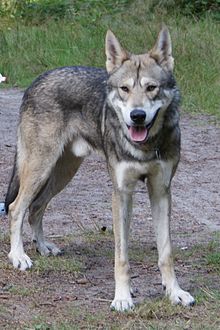 Films featuring Alaskan wolves usually employ domesticated wolf-dog hybrids to stand in for wild wolves.
Films featuring Alaskan wolves usually employ domesticated wolf-dog hybrids to stand in for wild wolves.
Alaska's first independent picture all made on place was in the silent years. The Chechahcos was produced by Alaskan businessman Austin E. Lathrop and filmed in and around Anchorage. It was released in 1924 by the Alaska Moving Picture Corporation and was the only film the company made.
One of the most prominent movies filmed in Alaska is MGM's Eskimo/Mala The Magnificent, starring Alaska Native Ray Mala. In 1932 an expedition set out from MGM's studios in Hollywood to Alaska to film what was then billed as "The Biggest Picture Ever Made." Upon arriving in Alaska, they set up "Camp Hollywood" in Northwest Alaska, where they lived during the duration of the filming. Louis B. Mayer spared no expense in spite of the remote location, going so far as to hire the chef from the Hotel Roosevelt in Hollywood to prepare meals. When Eskimo premiered at the Astor Theatre in New York City, the studio received the largest amount of feedback in its history to that point. Eskimo was critically acclaimed and released worldwide; as a result, Mala became an international movie star. Eskimo won the first Oscar for Best Film Editing at the Academy Awards, and was also responsible for showcasing and preserving aspects of Inupiat culture on film.
The 1983 Disney movie Never Cry Wolf was at least partially shot in Alaska. The 1991 film White Fang, starring Ethan Hawke, was filmed in and around Haines, Alaska. Steven Seagal's 1994 On Deadly Ground, starring Michael Caine, was filmed in part at the Worthington Glacier near Valdez.[81] The 1999 John Sayles film Limbo, starring David Strathairn, Mary Elizabeth Mastrantonio, and Kris Kristofferson, was filmed in Juneau.
The psychological thriller Insomnia, starring Al Pacino and Robin Williams, was shot in Canada, but was set in Alaska. The 2007 horror feature 30 Days of Night is set in Barrow, Alaska, but was filmed in New Zealand. Most films and television shows set in Alaska are not filmed there; for example, Northern Exposure, set in the fictional town of Cicely, Alaska, was actually filmed in Roslyn, Washington.
The 2007 film directed by Sean Penn, Into The Wild, was partially filmed and set in Alaska. The film, which is based on the novel of the same name, follows the adventures of Christopher McCandless, who died in a remote abandoned bus along the Stampede Trail west of Healy in 1992.
State symbols
- State Motto: North to the Future
- Nicknames: "The Last Frontier" or "Land of the Midnight Sun" or "Seward's Icebox"
- State bird: Willow Ptarmigan, adopted by the Territorial Legislature in 1955. It is a small (15–17 inches) Arctic grouse that lives among willows and on open tundra and muskeg. Plumage is brown in summer, changing to white in winter. The Willow Ptarmigan is common in much of Alaska.
- State fish: King Salmon, adopted 1962.
- State flower: wild/native Forget-Me-Not, adopted by the Territorial Legislature in 1917.[82] It is a perennial that is found throughout Alaska, from Hyder to the Arctic Coast, and west to the Aleutians.
- State fossil: Woolly Mammoth, adopted 1986.
- State gem: Jade, adopted 1968.
- State insect: Four-spot skimmer dragonfly, adopted 1995.
- State land mammal: Moose, adopted 1998.
- State marine mammal: Bowhead Whale, adopted 1983.
- State mineral: Gold, adopted 1968.
- State song: "Alaska's Flag"
- State sport: Dog Mushing, adopted 1972.
- State tree: Sitka Spruce, adopted 1962.
- State dog: Alaskan Malamute, adopted 2010.[83]
- State soil: Tanana,[84] adopted unknown.
See also
- Outline of Alaska
- Index of Alaska-related articles
- List of National Register of Historic Places in Alaska
- List of people from Alaska
- List of places in Alaska
- U.S. state
References
- ^ "Language Legislation in the U.S.A.". CompuServe.com. Archived from the original on 2009-04-26. http://web.archive.org/web/20090426134135/http://ourworld.compuserve.com/homepages/JWCRAWFORD/langleg.htm.
- ^ "RCN – Digital Cable TV, High-Speed Internet Service & Phone in Boston, Chicago, New York City, Philadelphia, Washington, D.C. and the Lehigh Valley". Users.rcn.com. http://users.rcn.com/crawj/kritz.htm. Retrieved 2010-06-02.
- ^ a b "Resident Population Data – 2010 Census". United States Census Bureau. http://2010.census.gov/2010census/data/apportionment-pop-text.php. Retrieved 2011-02-27.
- ^ a b "Elevations and Distances in the United States". United States Geological Survey. 2001. http://egsc.usgs.gov/isb/pubs/booklets/elvadist/elvadist.html. Retrieved October 21, 2011.
- ^ "Census Bureau". Factfinder.census.gov. http://factfinder.census.gov/servlet/DTTable?_bm=y&-geo_id=04000US02&-ds_name=PEP_2007_EST&-mt_name=PEP_2007_EST_G2007_T001. Retrieved 2010-06-02.
- ^ Ransom, J. Ellis. 1940. Derivation of the Word "Alaska"'. American Anthropologist n.s., 42: pp. 550–551
- ^ Benson, Carl (1998-09-02). "Alaska's Size in Perspective". Geophysical Institute, University of Alaska Fairbanks. http://www.gi.alaska.edu/ScienceForum/ASF14/1404.html. Retrieved 2007-11-19.
- ^ The other three exclaves of the United States are the Northwest Angle of Minnesota, Point Roberts, Washington and Alburgh, Vermont.
- ^ Alaska.com. "Alaska.com". Alaska.com. http://www.alaska.com/regions/. Retrieved 2010-06-02.
- ^ Porco, Peter (June 23, 2003). "Long said to be second to Fundy, city tides aren't even close". Anchorage Daily News: A1.
- ^ "Alaska Hydrology Survey". Division of Mining, Land, and Water; Alaska Department of Natural Resources. http://www.dnr.state.ak.us/mlw/water/hydro/.
- ^ "Alaska Facts". Knls.org. Archived from the original on February 28, 2008. http://web.archive.org/web/20080228134807/http%3A//www.knls.org/English/akfact.htm. Retrieved 2010-06-02.
- ^ "Western States Data Public Land Acreage". Wildlandfire.com. 2007-11-13. http://www.wildlandfire.com/docs/2007/western-states-data-public-land.htm. Retrieved 2010-06-02.
- ^ a b Mean Annual Precipitation in Alaska-Yukon. Oregon Climate Service at Oregon State University. Retrieved October 23, 2006.[dead link]
- ^ a b "NOAA Weather Radio All Hazards Information — Alaska Weather Interesting Facts and Records" (PDF). National Oceanic and Atmospheric Administration. http://www.arh.noaa.gov/docs/AKWXfacts.pdf. Retrieved 2007-01-03.
- ^ a b "State Extremes". Western Regional Climate Center, Desert Research Institute. http://www.wrcc.dri.edu/htmlfiles/state.extremes.html. Retrieved 2007-01-03.
- ^ NOAA – National Oceanic and Atmospheric Administration "SD Weather History and Trivia for May: May 1". National Oceanic and Atmospheric Administration. http://www.crh.noaa.gov/fsd/?n=fsdtrivia05 NOAA – National Oceanic and Atmospheric Administration. Retrieved 2007-01-03.
- ^ "FAQ ALASKA — Frequently Asked Questions About Alaska: Weather". Statewide Library Electronic Doorway, University of Alaska Fairbanks. 2005-01-17. http://sled.alaska.edu/akfaq/aksuper.html#wea. Retrieved 2007-01-03.
- ^ Ned Rozell (2003-01-23). "The Coldest Place in North America". Geophysical Institute of the University of Alaska Fairbanks. http://www.gi.alaska.edu/ScienceForum/ASF16/1630.html. Retrieved 2007-01-03.
- ^ History for Barrow, Alaska. Monthly Summary for July 2006. Weather Underground. Retrieved October 23, 2006.
- ^ Свердлов Л. М. Русское поселение на Аляске в XVII в.? «Природа». М., 1992. № 4. С.67–69.
- ^ [1]
- ^ Аронов В. Н. Патриарх Камчатского мореходства. // «Вопросы истории рыбной промышленности Камчатки»: Историко-краеведческий сб. – Вып. 3. – 2000. Вахрин С. Покорители великого океана. Петроп.-Камч.: Камштат, 1993.
- ^ these three Aleutian outer islands are about 460 miles (740 km) away from continental USSR, 920 miles (1,480 km) from continental Alaska (U.S.), 950 miles (1,530 km) from Japan.
- ^ "Resident Population Data – 2010 Census". 2010.census.gov. http://2010.census.gov/2010census/data/apportionment-pop-text.php. Retrieved 2011-05-29.
- ^ a b c U.S. Census Bureau (2008-12-15). "Cumulative Estimates of the Components of Population Change for the United States, Regions and States: April 1, 2000 to July 1, 2008 (NST-EST2008-04)" (CSV). http://www.census.gov/popest/states/tables/NST-EST2008-04.csv. Retrieved 2009-01-16.
- ^ "Census Bureau". census.gov. http://www.census.gov/population/cen2000/phc-t2/tab01.txt. Retrieved 2010-11-07.
- ^ Bls.gov; Local Area Unemployment Statistics
- ^ "American FactFinder". Factfinder2.census.gov. 2010-10-05. http://factfinder2.census.gov/faces/tableservices/jsf/pages/productview.xhtml?pid=DEC_10_PL_QTPL&prodType=table. Retrieved 2011-05-29.
- ^ American FactFinder, United States Census Bureau. "Census Bureau". Factfinder.census.gov. http://factfinder.census.gov/servlet/ADPTable?_bm=y&-geo_id=04000US02&-qr_name=ACS_2007_3YR_G00_DP3YR2&-ds_name=ACS_2007_3YR_G00_&-_lang=en&-redoLog=false&-_sse=on. Retrieved 2010-06-02.
- ^ "Adherents.com". Adherents.com. http://www.adherents.com/Na/Na_472.html. Retrieved 2010-06-02.
- ^ "Believe it or not, Alaska's one of nation's least religious states". Anchorage Daily News. 2008-07-13. Archived from the original on 2009-01-16. http://web.archive.org/web/20090116035021/http://www.adn.com/life/story/463303.html.
- ^ "Religious Affiliations 2000". Alaska State Membership Report. Association of Religion Data Archives. http://www.thearda.com/mapsReports/reports/state/02_2000.asp. Retrieved 2008-03-31.
- ^ "LDS Newsroom Statistical Information". Newsroom.lds.org. Archived from the original on July 30, 2008. http://web.archive.org/web/20080730060850/http%3A//newsroom.lds.org/ldsnewsroom/eng/statistical-information. Retrieved 2010-06-02.
- ^ Dixon, Martha (2004-09-12). "Religious legacy lives on in Alaska". BBC News. http://news.bbc.co.uk/2/hi/americas/3531458.stm. Retrieved 2010-06-02.
- ^ "Welcome to SLED: FAQ Alaska". Sled.alaska.edu. http://sled.alaska.edu/akfaq/akchron.html. Retrieved 2010-06-02.
- ^ "An early Russian Orthodox Church". Vilda.alaska.edu. http://vilda.alaska.edu/u?/cdmg11,4904. Retrieved 2010-06-02.
- ^ "Association of Religion Data Archive". Thearda.com. http://www.thearda.com/mapsReports/maps/map.asp?state=101&variable=201. Retrieved 2010-06-02.
- ^ http://www.census.gov/compendia/statab/2011/tables/11s0077.pdf
- ^ "First Muslim cemetery opens in Alaska". Archived from the original on 2009-01-16. http://web.archive.org/web/20090116035850/http://dwb.adn.com/news/alaska/ap_alaska/story/8656236p-8548061c.html.
- ^ "Engaging Muslim: Religion, Culture, Politics". Archived from the original on 2009-02-15. http://web.archive.org/web/20090215202834/http://engagingmuslims.alaskapacific.edu/.
- ^ "Alaskan Muslims Avoid Conflict". Humanitynews.net. 2005-07-07. http://www.humanitynews.net/index.php/main/more/alaskan_muslims_avoid_conflict/. Retrieved 2010-06-02.
- ^ "Mosque milestone for Alaska Muslims – Americas". Al Jazeera English. 2010-12-25. http://english.aljazeera.net/video/americas/2010/12/20101225111741183159.html. Retrieved 2011-05-29.
- ^ Kalyan, Mala. "Shri Ganesha Mandir of Alaska". Cultural Association of India Anchorage. Archived from the original on 2009-02-11. http://web.archive.org/web/20090201151519/http://caia.arctic.us/?Shri_Ganesha_Mandir_of_Alaska.
- ^ "Hindu Temples in USA – Hindu Mandirs in USA". Hindumandir.us. http://www.hindumandir.us/west-coast.html#AK. Retrieved 2010-06-02.
- ^ "Holi & Baisakhi celebrated by Alaskan Hindus and Sikhs". Cultural Association of India Anchorage. Archived from the original on 2009-02-11. http://web.archive.org/web/20090201151459/http://caia.arctic.us/?Holi_%2F_Baisakhi_Celebration%3A.
- ^ "Alaska's 100 Largest Private Sector Employers in 2010 (July 2011 Alaska Economic Trends)." Alaska Department of Labor and Workforce Development (2007).
- ^ "Gas Hydrates on Alaska's North Slope". Usgs.gov. http://www.usgs.gov/corecast/details.asp?ep=74. Retrieved 2010-06-02.
- ^ "EIA State Energy Profiles: Alaska". Tonto.eia.doe.gov. 2009-08-27. http://tonto.eia.doe.gov/state/state_energy_profiles.cfm?sid=AK. Retrieved 2010-11-07.
- ^ "Screening Report for Alaska Rural Energy Plan". 2001-04. Archived from the original on 2008-02-16. http://web.archive.org/web/20080216014031/http://www.dced.state.ak.us/dca/AEIS/PDF_Files/AIDEA_Energy_Screening.pdf.
- ^ Alaska Permanent Fund Corporation
- ^ "State of Alaska Permanent Fund Division". Pfd.state.ak.us. http://www.pfd.state.ak.us/dividendamounts/index.aspx. Retrieved 2010-06-02.
- ^ FreeShipping.org for examples of companies offering free shipping to Alaska
- ^ "Alaska Department of Fish and Game". Adfg.alaska.gov. http://www.adfg.alaska.gov/index.cfm?adfg=fishingPersonalUse.main. Retrieved 2011-05-29.
- ^ "Reindeer Herding". Reindeer.salrm.uaf.edu. http://reindeer.salrm.uaf.edu/about_reindeer/seward_peninsula.php. Retrieved 2010-11-07.
- ^ completion of the 3.5 mile (5.6 km) Interstate 93 tunnel as part of the "Big Dig" project in Boston, Massachusetts.
- ^ Barbara Yaffe (2011-01-02). "Alaska Oil / BC Tar sands via rail". http://communities.canada.com/vancouversun/blogs/powerplay/archive/2010/12/13/transporting-oil-across-b-c.aspx. Retrieved 2011-01-02.
- ^ Allan Dowd (2007-06-27). "Economic study touts Alaska-Canada rail link". Reuters. http://www.reuters.com/article/idUSN2138860820070622. Retrieved 2011-01-02.
- ^ AlaskaCanadaRail.org (2005-01-02). "Alaska Canada Rail Link". http://alaskacanadarail.com/index.html. Retrieved 2011-01-02.
- ^ State of Alaska Office of Economic Development. Alaska Visitor Arrivals and Profile-Summer 2001. November, 2002. Retrieved September 11, 2006.[dead link]
- ^ State of Alaska Office of Economic Development. Alaska Visitor Arrivals and Profile-Fall/Winter 2001. November, 2002. Retrieved September 11, 2006.
- ^ Federal Aviation Administration. 2005 U.S. Civil Airman Statistics
- ^ "Norman Vaughan Serum Run". United Nations. 2010-04-15. http://www.serumrun.org/. Retrieved 2010-06-02.
- ^ "State of Alaska". Dop.state.ak.us. http://dop.state.ak.us/employeeOrientation/introduction. Retrieved 2010-06-02.
- ^ a b c d "About the Alaska Court System". State.ak.us. http://www.state.ak.us/courts/ctinfo.htm. Retrieved 2010-06-02.
- ^ "National Journal Alaska State Profile". Election.nationaljournal.com. http://election.nationaljournal.com/states/ak.htm. Retrieved 2010-06-02.
- ^ Volz, Matt (2006-07-11). "Judge rules against Alaska marijuana law". The Seattle Times (Frank A. Blethen). http://seattletimes.nwsource.com/html/localnews/2003118645_webpot10.html. Retrieved 2008-05-22.
- ^ Doughtery, J. (2001, February 25). Alaska party stumps for independence. World Net Daily. Retrieved from A Free Press for a Free People
- ^ CNN Money (2005). "How tax friendly is your state?" Retrieved from CNN website.
- ^ "Department of Revenue Tax Division". Tax.state.ak.us. http://www.tax.state.ak.us/. Retrieved 2010-06-02.
- ^ "Educating Taxpayers Since 1937". The Tax Foundation. http://www.taxfoundation.org/research/topic/11.html. Retrieved 2010-06-02.
- ^ "State of Alaska". Gov.state.ak.us. Archived from the original on 2008-02-25. http://web.archive.org/web/20080225223222/http://www.gov.state.ak.us/ltgov/elections/regbypty.htm. Retrieved 2010-06-02.
- ^ "Alaska ICE". Alaska ICE. http://www.alaskaice.org/material.php?matID=138. Retrieved 2010-06-02.[dead link]
- ^ These are the only three universities in the state ranked by US News and World Report. [2]
- ^ "UA Scholars Program – Frequently Asked Questions". Archived from the original on 2008-03-09. http://web.archive.org/web/20080309023826/http://www.alaska.edu/scholars/faq.xml. Retrieved 2009-12-28.
- ^ "AK Dept. of Public Safety Alcoholic Beverage Control Board". Dps.state.ak.us. http://www.dps.state.ak.us/abc/restrictions.aspx. Retrieved 2010-06-02.
- ^ "State of Alaska". Hss.state.ak.us. http://www.hss.state.ak.us/suicideprevention/statistics_pages_sspc/AKsuiciderate_rural_urban_90-00.htm. Retrieved 2010-06-02.
- ^ "Alaska State Troopers FY 2008 Byrne Grant Application" (PDF). http://notes5.state.ak.us/pn/pubnotic.nsf/0/8dad412f35cf9ba1892574e30001c413/$FILE/JAG+supplemental+program+narrative.pdf. Retrieved 2010-06-02.
- ^ D'oro, Rachel (2008-01-30). "Rural Alaska steeped in sexual violence". USA Today. http://www.usatoday.com/news/nation/2008-01-29-alaska-sexualassaults_N.htm. Retrieved 2010-12-31.
- ^ www.alaskanativearts.org
- ^ "On Deadly Ground". Filminamerica.com. http://www.filminamerica.com/Movies/OnDeadlyGround/. Retrieved 2010-11-07.
- ^ "Alaska Conservation Foundation – State Symbols". Archived from the original on 2009-02-25. http://web.archive.org/web/20090225094636/http://akcf.org/_pages/about_ACF/about_alaska/state_symbols.php.
- ^ "It's official: Malamute now Alaska's state dog – KTUU.com | Alaska's news and information source |". KTUU.com. 2010-05-12. http://www.ktuu.com/Global/story.asp?S=12473783. Retrieved 2010-06-02.[dead link]
- ^ TANANA – ALASKA STATE SOIL U.S. Department of Agriculture
External links
- Alaska Community Database System
- Alaska's Digital Archives
- Alaska, project area of the American Land Conservancy
- Alaska Inter-Tribal Council
- Alaska at the Open Directory Project
- Big, Beautiful Alaska – slideshow by Life magazine
- U.S. Government
- Energy & Environmental Data for Alaska
- USGS real-time, geographic, and other scientific resources of Alaska
- US Census Bureau
- Alaska State Facts
- Documents on Alaskan Statehood at the Dwight D. Eisenhower Presidential Library
- Guide to collections containing information on Alaskan statehood at the Eisenhower Presidential Library
- State government
- State of Alaska website
- Alaska State Databases – Annotated list of searchable databases produced by Alaska state agencies and compiled by the Government Documents Roundtable of the American Library Association.
- Alaska Department of Natural Resources, Recorder's Office
Coordinates: 64°N 153°W / 64°N 153°W

Chuckchi Sea  Russia
Russia
Arctic OceanBeaufort Sea 
 Russia • Bering Strait
Russia • Bering Strait
Chukotka
 Canada
Canada
 Yukon
Yukon
 Alaska
Alaska 

Bering Sea
Pacific Ocean
 Japan
JapanPacific Ocean
 Hawaii
Hawaii Canada
Canada
 British Columbia
British ColumbiaPreceded by
ArizonaList of U.S. states by date of statehood
Admitted on January 3, 1959 (49th)Succeeded by
HawaiiCategories:- Alaska
- Arctic Ocean
- Exclaves in the United States
- States and territories established in 1959
- States of the United States
- West Coast of the United States
Wikimedia Foundation. 2010.


